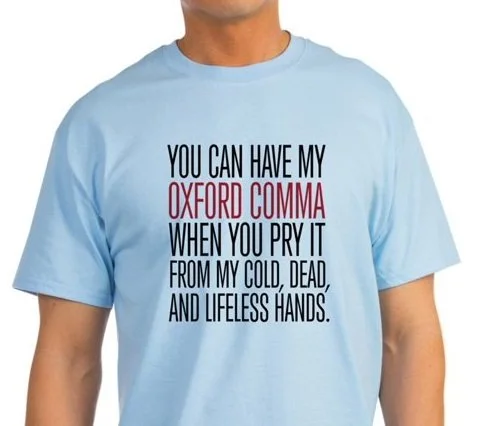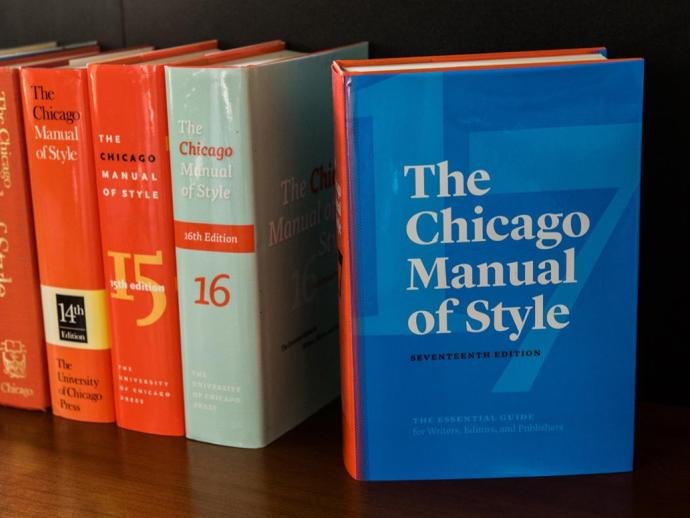The Oxford Comma and Other Grammarly Events
During a recent Saturday morning drive, I happened upon a discussion between Scott Simon and Ellen Jovin on his “Weekend Edition” show.
Jovin is a grammar expert, and she takes to the road from time to time to give her advice on how to use — and not use — the English language. But she does not, she said, take a stand on the Oxford comma.
“I don’t actually care whether people use it,” she said. “I currently use it, but I have gone through life stages without it, and I’ve been perfectly happy either way.”
Of course, whether to employ the Oxford comma is a debate that rages from deep in the hearts of those who swear by it and equally as passionately from those who despise it.
I’ve had the good fortune to live in both worlds and in some in-between ones. What I can tell you is this: The Oxford comma doesn’t matter nearly as much as either side would have you believe.
The reason why is unfortunate, and it’s this: Most of America doesn’t know what the Oxford comma is. And all 100 percent of them don’t care.
Even people who know what it is, most don’t care.
Rules of style, it seems, depend fully upon the person who owns the medium. Their decision is the only one that matters, and all rules flow from there.
Credit: WalMart
AP Style
I spent more than a generation working at newspapers. And the style guide of choice for them all is — or was — The Associated Press Style Book. Or, as it is commonly referred to in newsrooms, AP Style.
And AP style means . . . no Oxford commas.
When I left newspapers for a gig running a couple business-related websites, the style was AP style, except when we wanted to change something and have our own little bit of style mixed in. And when we did that . . . nobody cared.
In fact, when you leave the world of professional wordsmithing in any capacity, you discover that there are many people — as it, almost everyone — who not only don’t give a hoot about whether to use a comma before the last element in a series, they also don’t care if someone uses no punctuation. Many people don’t care about typos unless the typo happens to be in their name.
What Is the Oxford Comma?
The Oxford comma is the comma that sits between the last two elements in a series of them. Take this example: The colors of the American flag are red, white, and blue.
The Oxford comma is the comma paired with the word “white.”
With AP style, the sentence would be: The colors of the America flag are red, white and blue.
That’s right: no comma after white.
But people who support the use of the Oxford comma are devout and diligent. There are many, many memes and shirts dedicated to its promotion. Such as: You can have my Oxford comma when you pry it from my cold, dead, and lifeless hands.
This debate largely ignores the other debate that rages, which is the lack of use of any commas. Such as these examples:
“Let’s eat kids,” vs. “Let’s eat, kids.” The punchline: “Punctuation saves lives.”
The Style for Writing Books
The Chicago Manual of Style, all 900-plus pages.
If you move from any form of writing to one of writing books, your style guide changes. When it comes to books, the bible is The Chicago Manual of Style.
It is a behemoth of a book, nearly 1,000 pages, and its keepers price it accordingly. The style book costs at least $50 no matter where you look, although the good news is that if you buy it, you should only need one copy for your writing lifetime. Yes, editors published updated versions every two to five years. But still . . .
In the Chicago Manual of Style, the Oxford comma is alive and well: Chapter 6, section 6.19, “Series and the Serial Comma.”
6.19 Comma needed. Items in a series are normally separated by commas. . . . When a conjunction joins the last two elements in a series, a comma — known as the serial or series comma or the Oxford comma — should appears before the conjunction. Chicago strongly recommends this widely practiced usage . . .
My advice to any would-be author is to heed Section 6.19. If you submit a manuscript that neglects the Oxford comma, you’re going to gain a swift rejection letter just for ignoring a rule editors and publishers take to heart.
I wrote multiple drafts of Dead Odds with no Oxford comma, realizing at some point that I would have to do (at least) one full edit of a polished manuscript to ensure I made the changes. I think that was edit No. 10 of nearly two dozen.
All that matters, though, is that it got done before my hired editor got his hands on it.
More Style Disagreements
Another style issue that journalists turned authors must confront is that of numbers. Both AP Style and Chicago Manual of Style have simple, but different, preferences. Here is the same sentence in both styles:
AP Style: The woman ordered a $15 martini, a 12-piece shrimp cocktail and change for a $100 bill.
Chicago Style: The woman ordered a fifteen-dollar martini, a twelve-piece shrimp cocktail, and change for a hundred-dollar bill.
(The sentence also has the Oxford comma/no Oxford comma example as well.)
I can’t explain why the Chicago editors, and publishing houses around the world, prefer to spell out so many numbers. It’s rooted in history, I’m sure, but I didn’t grow up in that world, so I don’t know background.
For the AP editors, the rationale that was explained to me in journalism school had everything to do with saving money by saving type, saving space and therefore saving money.
I suppose there’s something to be said for spelling out numbers and other elements in a book so that they are digested as text. When it comes to numbers, though, I’d happily adopt a style that doesn’t officially exist. That is, no numbers get spelled out. All of them get written as pure numbers.
For example:
AP style: He ordered two hamburgers, two hotdogs and four Cokes.
Non-existent style: He ordered 2 hamburgers, 2 hot dogs and 4 Cokes.
I say I’d adopt it, but I haven’t. Remember what I said about the owner a medium or platform making their own style decisions? I could go with the pure numbers change, but that’s a radical change for someone who is only a moderate rebel.
Another style issue is that of em-dashes. These are the longish dashes that many non-authors use as an appositive.
An example is: Most football fans acknowledge Tom Brady — the NFL quarterback with seven Super Bowl rings — as the great quarterback of all time.
The dashes contain a descriptor.
Notice how the dashes don’t touch on either side. That’s pretty standard. But in books, Chicago style dictates that not only do the dashes touch something, but they are also used differently. They can be used to “amplify or explain,” as above, but they also indicate sudden breaks, such as an interruption during a conversation. Such as:
“At first I thought you were going to tell me you’re moving—”
“I’d never leave here,” she said.
Notice that Chicago style has the dashes mashed up against other words. That’s another difference.
Given that that the Chicago Manual of Style is so long and so detailed, much more so than the AP Stylebook, it has much more detail. And for all you other authors out there, it bears reading and understanding. Otherwise you’re putting yourself at a disadvantage when it comes time to query.
Which is to say this: I learned my lesson learned about style and the manuscript. In the current draft of Dead Sleep, which is close to conclusion, has Oxford commas.
And yet, if you haven’t noticed by now, despite my author bona fides, this blog doesn’t use the Oxford comma.
Sue me.

